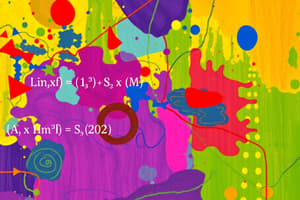Podcast
Questions and Answers
What can be concluded about the degrees of the numerator and denominator?
What can be concluded about the degrees of the numerator and denominator?
- The degree of the denominator is less than the degree of the numerator.
- The degree of the denominator is greater than the degree of the numerator. (correct)
- The degree of the denominator is equal to the degree of the numerator.
- The degrees of the numerator and denominator cannot be compared.
What is the limit of the sequence $u_n = \frac{n}{n^2 + 1}$ as $n$ approaches infinity?
What is the limit of the sequence $u_n = \frac{n}{n^2 + 1}$ as $n$ approaches infinity?
- 1
- 0 (correct)
- Infinity
- Undefined
Using the properties of the cosine function, what is the range of $\cos\frac{\pi}{n}$?
Using the properties of the cosine function, what is the range of $\cos\frac{\pi}{n}$?
- All real numbers
- 0 to 1
- -1 to 1 (correct)
- -1 to 0
Given the inequality $- \frac{n}{n^2 + 1} \leq v_n \leq \frac{n}{n^2 + 1}$, what can be inferred about $v_n$ as $n$ approaches infinity?
Given the inequality $- \frac{n}{n^2 + 1} \leq v_n \leq \frac{n}{n^2 + 1}$, what can be inferred about $v_n$ as $n$ approaches infinity?
Which statement accurately represents the limit behavior of $\lim_{n \to \infty} u_n = \lim_{n \to \infty} \frac{\frac{1}{n}}{1 + \frac{1}{n^2}}$?
Which statement accurately represents the limit behavior of $\lim_{n \to \infty} u_n = \lim_{n \to \infty} \frac{\frac{1}{n}}{1 + \frac{1}{n^2}}$?
How does the sequence $u_n$ behave as $n$ goes to infinity?
How does the sequence $u_n$ behave as $n$ goes to infinity?
What is the implication of the inequality $-1 \leq \cos\frac{\pi}{n} \leq 1$ in the context of sequences?
What is the implication of the inequality $-1 \leq \cos\frac{\pi}{n} \leq 1$ in the context of sequences?
What happens to the term $\frac{n}{n^2 + 1}$ as $n$ tends to infinity?
What happens to the term $\frac{n}{n^2 + 1}$ as $n$ tends to infinity?
What is the limit of $v_n$ as $n$ approaches infinity?
What is the limit of $v_n$ as $n$ approaches infinity?
Which term in the Taylor series expansion for $\cos x$ contributes to the limit calculation as $x$ approaches 0?
Which term in the Taylor series expansion for $\cos x$ contributes to the limit calculation as $x$ approaches 0?
In the limit expression for $\lim_{n \rightarrow \infty} v_n$, what does the term $\frac{\pi^2}{2 n^3}$ represent?
In the limit expression for $\lim_{n \rightarrow \infty} v_n$, what does the term $\frac{\pi^2}{2 n^3}$ represent?
What substitution is made for $x$ in the expression $\cos\frac{\pi}{n}$ when applying Taylor expansion?
What substitution is made for $x$ in the expression $\cos\frac{\pi}{n}$ when applying Taylor expansion?
Which of the following represents the approximation for large $n$ in the calculation of $\frac{n}{n^2 + 1}$?
Which of the following represents the approximation for large $n$ in the calculation of $\frac{n}{n^2 + 1}$?
What does $o\left( \frac{1}{n^2} \right)$ indicate in the context of limit evaluation?
What does $o\left( \frac{1}{n^2} \right)$ indicate in the context of limit evaluation?
Which of the following correctly identifies the behavior of $v_n$ as $n$ increases indefinitely?
Which of the following correctly identifies the behavior of $v_n$ as $n$ increases indefinitely?
What is the main consequence of using Taylor series expansion for evaluating limits involving trigonometric functions?
What is the main consequence of using Taylor series expansion for evaluating limits involving trigonometric functions?
Flashcards are hidden until you start studying
Study Notes
Limit Analysis
- The degree of the numerator ( n ) is 1, and the degree of the denominator ( n^2 + 1 ) is 2.
- The degree of the denominator is greater than that of the numerator.
- As ( n ) approaches infinity, both ( \frac{n}{n^2 + 1} ) and ( \frac{1}{n} ) converge to 0.
- Therefore, ( \lim_{n \to \infty} u_n = 0 ).
Inequality Method
- The property of cosine states ( -1 \leq \cos\left( \frac{\pi}{n} \right) \leq 1 ).
- ( v_n ) is bounded by the inequalities ( -\frac{n}{n^2 + 1} \leq v_n \leq \frac{n}{n^2 + 1} ).
- As ( n ) approaches infinity, ( \lim_{n \to \infty} \frac{n}{n^2 + 1} = 0 ).
- Thus, ( \lim_{n \to \infty} v_n = 0 ).
Taylor Expansion Approach
- The Taylor series expansion of cosine around 0 gives ( \cos x = 1 - \frac{x^2}{2} + o(x^2) ).
- When substituting ( x = \frac{\pi}{n} ), it gives ( \cos\left( \frac{\pi}{n} \right) = 1 - \frac{\left( \frac{\pi}{n} \right)^2}{2} + o\left( \frac{1}{n^2} \right) ).
- The expression for ( v_n ) derives as ( v_n = \frac{n\left( 1 - \frac{\pi^2}{2n^2} + o\left( \frac{1}{n^2} \right) \right)}{n^2 + 1} ).
- Simplification leads to ( v_n \approx \frac{1}{n} - \frac{\pi^2}{2n^3} + o\left( \frac{1}{n^3} \right) ).
- Consequently, ( \lim_{n \to \infty} v_n = 0 ).
Key Concepts
- Understanding limits of sequences when comparing degrees of numerators and denominators.
- Application of inequalities to establish bounds on sequences.
- Utilizing Taylor series for approximating function behavior near specific points of interest.
Studying That Suits You
Use AI to generate personalized quizzes and flashcards to suit your learning preferences.




